它来了它来了!25年最亮的一颗彗星来了,错过再等6800年
太空来客Neowise彗星本月造访地球,让天文观测者目眩神迷。
这是近25年来最亮的一颗彗星,北半球一直到8月中旬都可以看到。这颗来自外太空的天体将于7月23日抵达离地球最近的位置,距地球仅6400万英里,和水星离地球的平均距离大致相当。
它的官方名字是C/2020 F3 (NEOWISE),人们用肉眼就可以看到它出现在天空的西北部。它就位于大熊座下方,一整个晚上都能看到。
之后的每天晚上,彗星会在天空中越升越高,直到最终从人们的视野中消失。等到它重返地球,估计要到6800年后了。
除了夜间,早起的人暂时也能看到Neowise彗星。在日出前一小时向东北方向看,可以看到它拖着尾巴的痕迹,接下来几天,它会滑到地平线以下,消失在人们视线之外。
访问美国国家航空和航天局官网(NASA.gov)或《天空和望远镜》杂志(Sky & Telescope),即可获得更多观测细节。还可以登陆一个由NASA志愿者开发的在线应用程序,输入自己的位置,确定最佳观看时机。
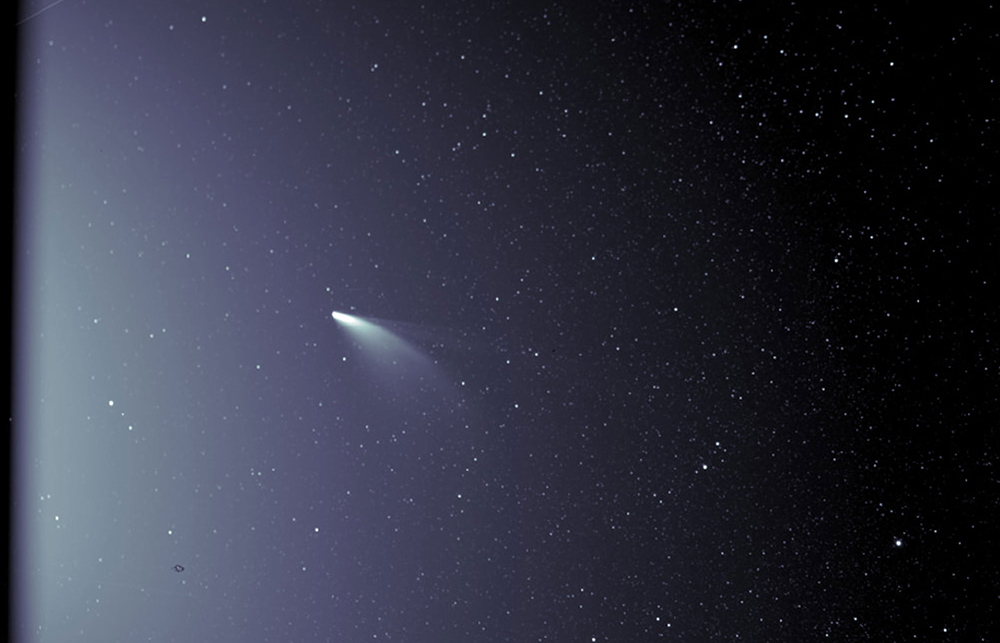
我们对Neowise彗星了解多少?
Neowise是一个布满尘埃的冰球,它不断高速飞行,和太阳系一样古老,已经46亿岁了。
这条3英里长的太空冰柱被认为起源于外层空间一个叫做奥尔特云的区域。这片云是行星形成时遗留下来的冰冻岩石碎片的墓地,存在时间远远超过了海王星和冥王星的轨道。
尽管Neowise很古老,但它直到最近才被科学家发现。3月27日,NASA的天文学家通过太空望远镜发现了这颗雪球,用的望远镜也叫NEOWISE,和彗星同名。(NEOWISE是近地天体宽视场红外勘测探测器的首字母缩写。)

6月,从NASA的日地关系观测台(STEREO)观测彗星Neowise。
NASA使用NEOWISE望远镜搜寻可能危及地球的天体。比如,希克苏鲁伯小行星(按照撞击地今天在墨西哥的地名来命名)被认为在6500万年前撞击了地球,导致恐龙灭绝。
“我们希望,远在Neowise彗星这样的天体还没有接近地球时就能发现它们。”NEOWISE项目的首席研究员、亚利桑那大学的行星科学教授艾米•迈因策尔在给《财富》杂志的电子邮件中表示。她说,这颗彗星“非常大,大约和导致恐龙灭绝的那颗行星一样大”,但幸运的是,它“不会造成危险”。
科学家们希望通过研究像Neowise这样的彗星,了解更多关于太阳系起源的信息,同时避免可能出现的物种灭绝。“我们需要知道彗星和小行星是由什么组成的,知道它们有多易碎或者多牢固——如果有一天我们不得不把哪颗星星推离轨道的话。”迈因策尔说。
这颗彗星长什么样?
对肉眼来说,Neowise就像一颗模糊的星星划过天空。
这颗彗星的亮度将和附近的北斗七星差不多,北斗七星也被称为大熊星座。虽然并非必须,但一副双筒望远镜或望远镜能够提升观测体验。
就连天文学家观测时也充满敬畏。“由于我们对这些行星的搜索,得以看到一些非常美丽的存在,它们提醒我们与更广阔的宇宙之间的联系。” 迈因策尔说。
Neowise和大多数彗星一样,拖着两条延伸数百万英里的彗尾。第一条由尘埃碎片组成,由于反射阳光而发出金色的光芒。第二条尾巴由被太阳辐射撞击造成的带电气体粒子组成,向左边发出微弱的蓝光。
上一次从地球上看到彗星发出如此强烈的光芒还要追溯到上世纪90年代中期的海尔-波普彗星。
“天堂之门”(Heaven’s Gate)邪教的39名成员在这次天文事件期间于圣迭戈郊区集体自杀,闹得沸沸扬扬。他们相信这样做可以让他们搭上伴飞的外星飞船。
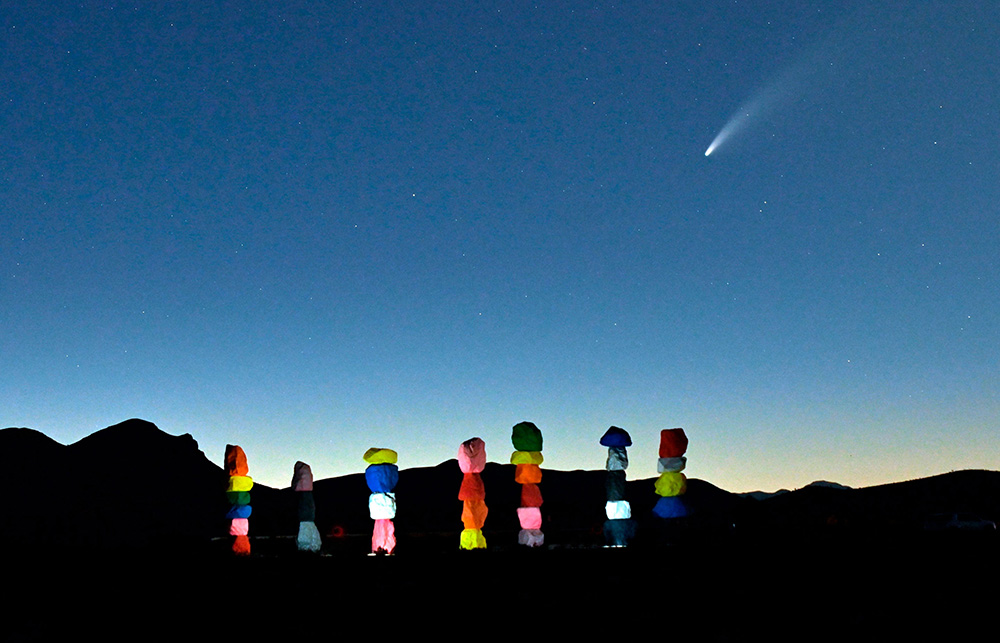
Neowise彗星的照片
Neowise在7月3日最接近太阳。在地球引力弹弓的推动下,这颗彗星正在向外太空回摆。
与Neowise不同的是,大多数彗星并不会呈现壮观的景象。今年早些时候还发现了ATLAS彗星和SWAN彗星,但它们都在自己的太空之旅中熄了火。
而最著名的哈雷彗星则是个特例。它是已知唯一一颗在生命周期中确定可以被短暂观测到的彗星。(请在你的日历上记下哈雷彗星下一次出现的时间:2061年7月28日。)
更常见的情况是,彗星无法预测、反复无常;我们无法确切知道下一颗彗星会在什么时候出现。因此,摄影师和天文学家都迫不及待地抓住机会,想要在Neowise的短暂逗留中捕捉它的美丽。
以下是我们最喜欢的一些图片示例。
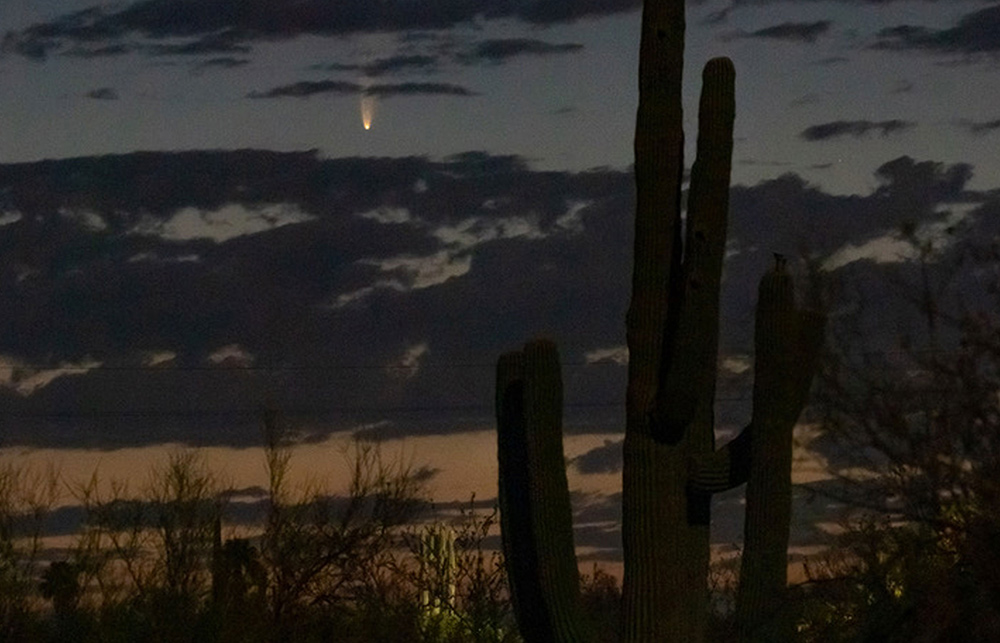
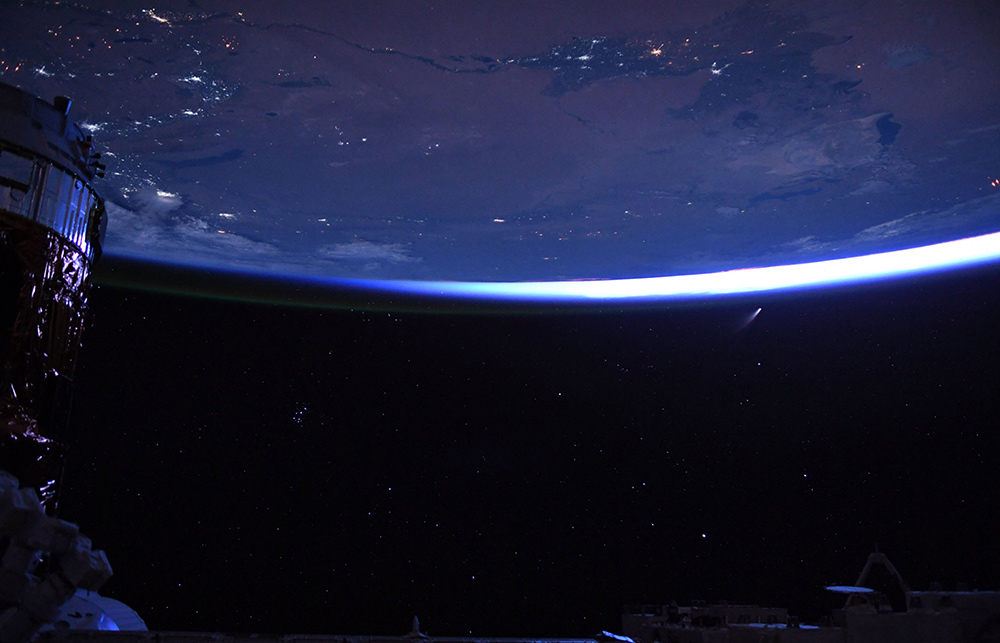

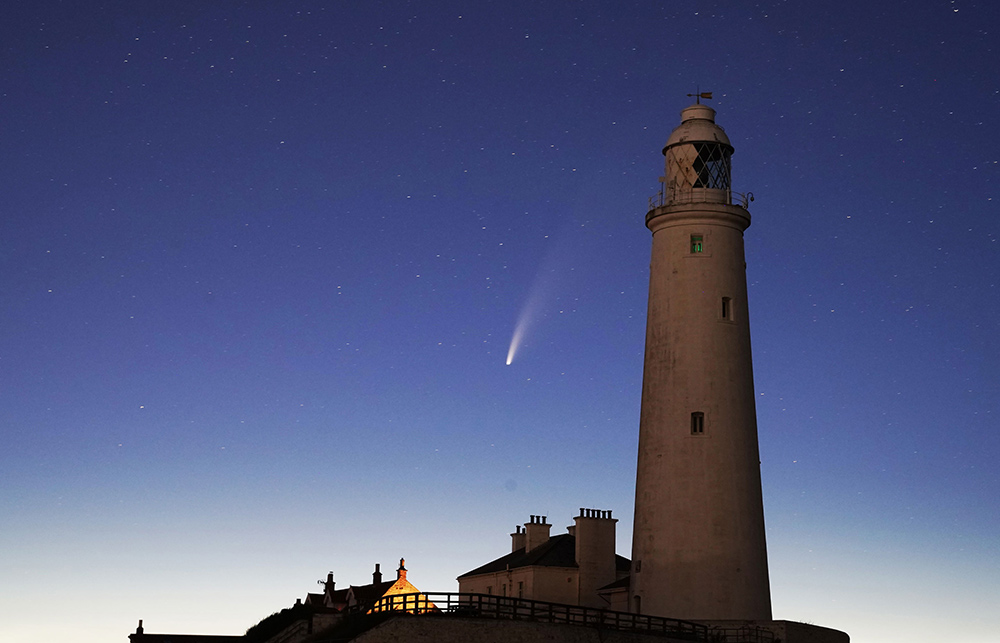

(财富中文网)
译者:Agatha
太空来客Neowise彗星本月造访地球,让天文观测者目眩神迷。
这是近25年来最亮的一颗彗星,北半球一直到8月中旬都可以看到。这颗来自外太空的天体将于7月23日抵达离地球最近的位置,距地球仅6400万英里,和水星离地球的平均距离大致相当。
它的官方名字是C/2020 F3 (NEOWISE),人们用肉眼就可以看到它出现在天空的西北部。它就位于大熊座下方,一整个晚上都能看到。
之后的每天晚上,彗星会在天空中越升越高,直到最终从人们的视野中消失。等到它重返地球,估计要到6800年后了。
除了夜间,早起的人暂时也能看到Neowise彗星。在日出前一小时向东北方向看,可以看到它拖着尾巴的痕迹,接下来几天,它会滑到地平线以下,消失在人们视线之外。
访问美国国家航空和航天局官网(NASA.gov)或《天空和望远镜》杂志(Sky & Telescope),即可获得更多观测细节。还可以登陆一个由NASA志愿者开发的在线应用程序,输入自己的位置,确定最佳观看时机。
7月5日的Neowise彗星,此时距它离太阳最近才过去不久。
我们对Neowise彗星了解多少?
Neowise是一个布满尘埃的冰球,它不断高速飞行,和太阳系一样古老,已经46亿岁了。
这条3英里长的太空冰柱被认为起源于外层空间一个叫做奥尔特云的区域。这片云是行星形成时遗留下来的冰冻岩石碎片的墓地,存在时间远远超过了海王星和冥王星的轨道。
尽管Neowise很古老,但它直到最近才被科学家发现。3月27日,NASA的天文学家通过太空望远镜发现了这颗雪球,用的望远镜也叫NEOWISE,和彗星同名。(NEOWISE是近地天体宽视场红外勘测探测器的首字母缩写。)
6月,从NASA的日地关系观测台(STEREO)观测彗星Neowise。
NASA使用NEOWISE望远镜搜寻可能危及地球的天体。比如,希克苏鲁伯小行星(按照撞击地今天在墨西哥的地名来命名)被认为在6500万年前撞击了地球,导致恐龙灭绝。
“我们希望,远在Neowise彗星这样的天体还没有接近地球时就能发现它们。”NEOWISE项目的首席研究员、亚利桑那大学的行星科学教授艾米•迈因策尔在给《财富》杂志的电子邮件中表示。她说,这颗彗星“非常大,大约和导致恐龙灭绝的那颗行星一样大”,但幸运的是,它“不会造成危险”。
科学家们希望通过研究像Neowise这样的彗星,了解更多关于太阳系起源的信息,同时避免可能出现的物种灭绝。“我们需要知道彗星和小行星是由什么组成的,知道它们有多易碎或者多牢固——如果有一天我们不得不把哪颗星星推离轨道的话。”迈因策尔说。
这颗彗星长什么样?
对肉眼来说,Neowise就像一颗模糊的星星划过天空。
这颗彗星的亮度将和附近的北斗七星差不多,北斗七星也被称为大熊星座。虽然并非必须,但一副双筒望远镜或望远镜能够提升观测体验。
就连天文学家观测时也充满敬畏。“由于我们对这些行星的搜索,得以看到一些非常美丽的存在,它们提醒我们与更广阔的宇宙之间的联系。” 迈因策尔说。
Neowise和大多数彗星一样,拖着两条延伸数百万英里的彗尾。第一条由尘埃碎片组成,由于反射阳光而发出金色的光芒。第二条尾巴由被太阳辐射撞击造成的带电气体粒子组成,向左边发出微弱的蓝光。
上一次从地球上看到彗星发出如此强烈的光芒还要追溯到上世纪90年代中期的海尔-波普彗星。
“天堂之门”(Heaven’s Gate)邪教的39名成员在这次天文事件期间于圣迭戈郊区集体自杀,闹得沸沸扬扬。他们相信这样做可以让他们搭上伴飞的外星飞船。
内华达州拉斯维加斯南部,Neowise彗星出现在艺术家乌戈•罗迪纳打造的“七魔山”(Seven Magic Mountains)艺术装置上方。
Neowise彗星的照片
Neowise在7月3日最接近太阳。在地球引力弹弓的推动下,这颗彗星正在向外太空回摆。
与Neowise不同的是,大多数彗星并不会呈现壮观的景象。今年早些时候还发现了ATLAS彗星和SWAN彗星,但它们都在自己的太空之旅中熄了火。
而最著名的哈雷彗星则是个特例。它是已知唯一一颗在生命周期中确定可以被短暂观测到的彗星。(请在你的日历上记下哈雷彗星下一次出现的时间:2061年7月28日。)
更常见的情况是,彗星无法预测、反复无常;我们无法确切知道下一颗彗星会在什么时候出现。因此,摄影师和天文学家都迫不及待地抓住机会,想要在Neowise的短暂逗留中捕捉它的美丽。
以下是我们最喜欢的一些图片示例。
7月6日,图森,日出前东北地平线上的Neowise彗星。
7月9日,宇航员罗伯特•本肯在国际空间站捕捉到了Neowise彗星。
7月11日,意大利莫菲塔,Neowise彗星在夕阳下闪耀。
7月14日凌晨,Neowise彗星经过英国惠特利湾的圣玛丽灯塔。
7月15日,法国南部圣米歇尔天文台,Neowise彗星经过一座古老风车的上方。
(财富中文网)
译者:Agatha
A space-born visitor, the Neowise comet, is dazzling skygazers this month.
The brightest comet to grace our skies in nearly a quarter century is visible in the Northern Hemisphere through mid-August. The celestial guest will make its closest approach to Earth on July 23 at a distance of 64 million miles—about equal to Mercury's average distance from Earth.
People can view the comet, officially, C/2020 F3 (NEOWISE)—with the naked eye in the northwest skies. The comet will appear all night under the Big Dipper constellation.
Each evening the comet climbs higher in the sky until eventually it fades from view. The space-rock is expected to return again in 6,800 years.
In addition to its nighttime show, Neowise is temporarily visible for early risers in the morning too. Look to the northeast about an hour before sunrise for the telltale trailing tail, which will slip beneath the horizon and out of view in the coming days.
Visit NASA.gov for additional observational details, or Sky & Telescope magazine. People can also enter their locations into a helpful online app developed by a NASA volunteer to determine the best viewing opportunities.
What do we know about the Neowise comet?
Neowise is a hurtling, dusty ball of ice that's as old as the solar system at 4.6 billion-years old.
The 3-mile-long space icicle is believed to have originated in a region of outer space called the Oort Cloud. The cloud is a graveyard of frozen rocky fragments leftover from the formation of the planets, and it exists far past the orbits of Neptune and Pluto.
Despite its age, scientists discovered Neowise only very recently. NASA astronomers detected the snowball on March 27 using a space telescope, also called NEOWISE, the comet's namesake. (The name stands for Near-Earth Object Wide-field Infrared Survey Explorer.)
NASA uses NEOWISE, the telescope, to hunt for celestial objects that could endanger Earth. One such missile—the Chicxulub impactor, named for its collision site in present-day Mexico—is believed to have annihilated the dinosaurs 65 million years ago.
"We want to spot objects like Comet Neowise well before they can make any close approaches," Amy Mainzer, principal investigator for the NEOWISE project and professor of planetary sciences at the University of Arizona, said in an email to Fortune. She notes that this one is "very large, about as big as the object that wiped out the dinosaurs," but that it fortunately "poses no hazard."
By studying comets like Neowise, scientists hope to learn more about the solar system's origins—and avoid potential extinction "We need to know what comets and asteroids are made of and how crumbly they are—or solid—if we ever have to push one out of the way," Mainzer says.
What does the comet look like?
To the naked eye, Neowise will appear as a fuzzy star streaking across the sky.
The comet will be about as bright as the stars appearing close by in the Big Dipper, a constellation also known as Ursa Major, or the Great Bear. While not required, a pair of binoculars or a telescope will enhance the view.
Even astronomers look on in awe. "As a byproduct of these searches, we get to see something really beautiful that reminds us of our connection to the larger universe.," Mainzer says.
Neowise, like most comets, has two tails that extend for millions of miles. The first, made of dusty debris, shines golden as it reflects sunlight. The second tail, made of electrically charged gas particles blasted by solar radiation, glows faintly blue toward the left.
The last time a comet blazed this intensely from our earthly vantage point was during the Hale-Bopp Comet's visitation in the mid-'90s.
Infamously, 39 members of the Heaven's Gate cult committed ritual suicide in a San Diego suburb during the astronomical event. They believed doing so would enable them to hitch a ride on an accompanying extraterrestrial spacecraft.
Photos of the Neowise comet
Neowise made its closest approach to the sun on July 3. The comet is now swinging back out into space, propelled by our star's gravitational slingshot.
Unlike Neowise, most comets present no spectacular show. Comet ATLAS and Comet SWAN, also discovered earlier this year, fizzled out during their cosmic circuits.
The most famous comet, Halley's, is an anomaly. It is the only known, reliably visible comet with a short enough period to be witnessed in the span of a lifetime. (Mark your calendar for the next appearance: July 28, 2061.)
More commonly, comets are unpredictable and capricious; there's no knowing exactly when the next one will gleam. So photographers and astronomers of all stripes are jumping at the opportunity to capture the beauty of Neowise's sojourn.
Here is a sampling of our favorites.













